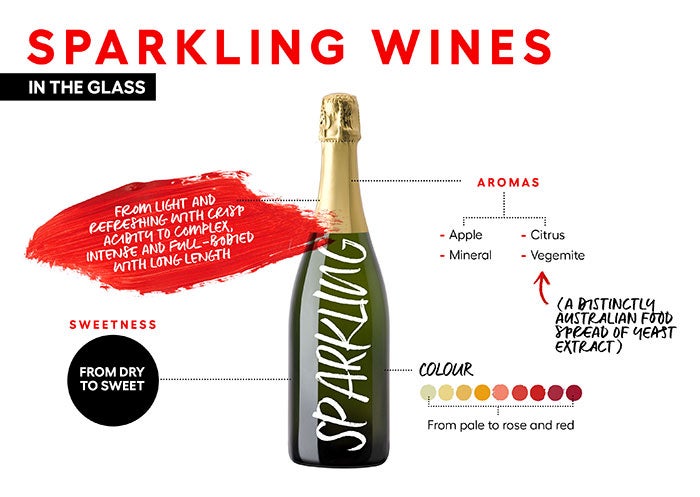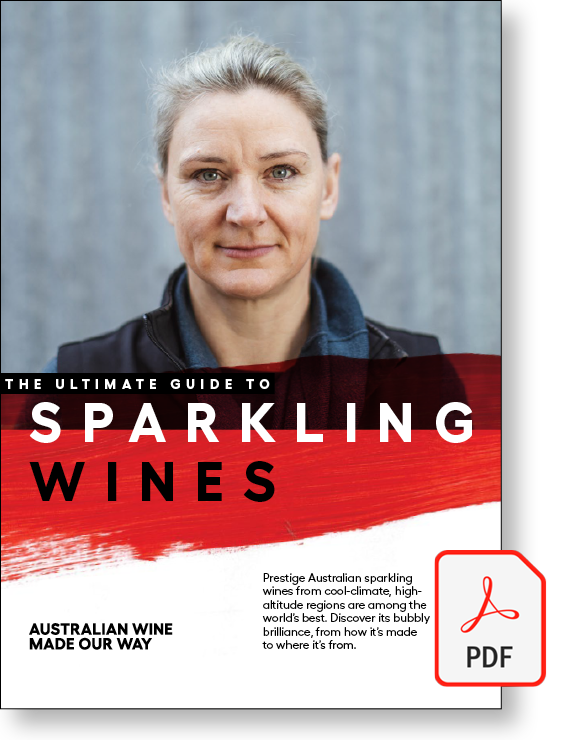The pop of a cork, the splash of foam, the bead of fine bubbles – there’s nothing quite like a sparkling wine. In Australia, talented winemakers craft some of the best in the world, and some of the most diverse, from premium traditional method sparkling to refreshing Prosecco and Moscato, and dazzling sparkling Shiraz.
One of Australia’s top sparkling winemakers, Ed Carr, has watched the rise of these wines, and says the turning point came in the 1970s and 80s when growers started planting the right grape varieties in the right areas – in cool-climate regions like Tasmania, the Adelaide Hills and the Yarra Valley.
“Since then, I think the quality has just improved immensely,” says Ed. “I think all premium Australian sparkling stands up very well on the world stage.”

Which grapes are used to make sparkling wine?
The most common grapes are Chardonnay, Pinot Noir and Pinot Meunier – these are the ones typically used in traditional method sparkling (which includes Champagne). Other grapes include Semillon, Chenin Blanc, Riesling, Crouchen, Trebbiano and Muscat Gordo Blanco.
Why are red grapes like Pinot Noir and Pinot Meunier used to make white sparkling? Using multiple varieties creates a more complex and balanced wine. The wine doesn’t turn red or pink because only the juice of the grapes is used – all the colour comes from the skins and these are quickly removed.
Australia is also famous for sparkling red wines, most commonly made with Shiraz grapes, but also Merlot, Cabernet Sauvignon and Durif.
How is sparkling wine made?
Making sparkling wine is more complex than making still wine, largely because it goes through two fermentations: the first to make wine and the second to make bubbles.
“The most intriguing thing about sparkling wine is that what we put into the bottle is not what we want people to taste when it’s released,” says Kate Laurie, who owns Adelaide Hills winery Deviation Road and is highly awarded for her traditional method sparkling. “A lot of the aromas and textures and the carbonation all happen after you bottle the wine. So there’s a lot of mystery that goes into it.”
It all starts in the vineyard, where grapes are carefully selected and harvested. Winemakers press grapes gently to avoid extracting any colour or tannins from the red varieties. The juice is fermented to produce a dry base wine, and then a ‘cuvée’ – the final sparkling wine blend – is made by blending different batches of wine. Once the cuvée is made, there are different methods for finishing the wine, each resulting in a different style. Below are three methods used in Australia.
Traditional method (méthode traditionnelle): This is the most well-known method and the one that’s mandatory for Champagne. It’s also the most complicated.
- It starts with producing a cuvée (the blended base wine).
- A mixture of sugar and yeast is added to the wine in bottles to start the second fermentation, which takes four to six weeks. Carbon dioxide is trapped inside the bottle and creates bubbles.
- The wines are left to age with the ‘lees’ (the dead yeast cells from fermentation) for at least nine months and often several years, which develops texture and flavour.
- The bottles are turned upside down so the lees collect in the bottle neck (called ‘riddling’)
- The bottlenecks are plunged into a freezing liquid to freeze the lees. The cap is then popped off and the frozen plug of lees shoots out (called ‘disgorging’). These days riddling and disgorging are usually done by machine.
- A mixture of wine and sugar is added to fill the bottles, and the bottles are sealed with a cork, wired and labelled.
“We’ve just released a couple of museum wines that were aged for 15 years,” says Ed, who established Tasmania’s House of Arras as Australia’s most prestigious sparkling wine producer. “They were amazingly complex but really bright and fresh. It’s great to be able to craft something like that over that period of time.”
Transfer method: This is the same as the traditional method, except that after the second fermentation and time on lees, the wine is removed from the bottle and transferred to a tank. It’s filtered in bulk to remove the yeast, then pumped into new bottles. Many Australian sparkling wines use this method, as it’s simpler but still produces high-quality wines.
Tank/charmat method: This is another popular method that can be more cost-effective. It’s used to make bright, fresh sparkling wines like Prosecco. It starts the same way as bottle-fermented wines, but once the first fermentation is complete, the wine is moved to a tank. The winemaker adds sugar and yeast to start the second fermentation and seals the tank to trap the carbon dioxide, creating bubbles. The winemaker then filters and bottles the wine without ageing.
Whatever the method and style, Australian sparkling wine is shining brighter than ever.
“Most people drink champagne to celebrate, but it actually suits any occasion or part of the day,” says Kate. “I think people are realising that there’s enough flavour and interest in the wine that it’s just really delicious, and it makes you want a second glass.”
Want to know more?
Download ‘The ultimate guide to sparkling wines’ to learn more about how and where Australian sparkling wines are made, different styles to try and how to serve it like an expert.






